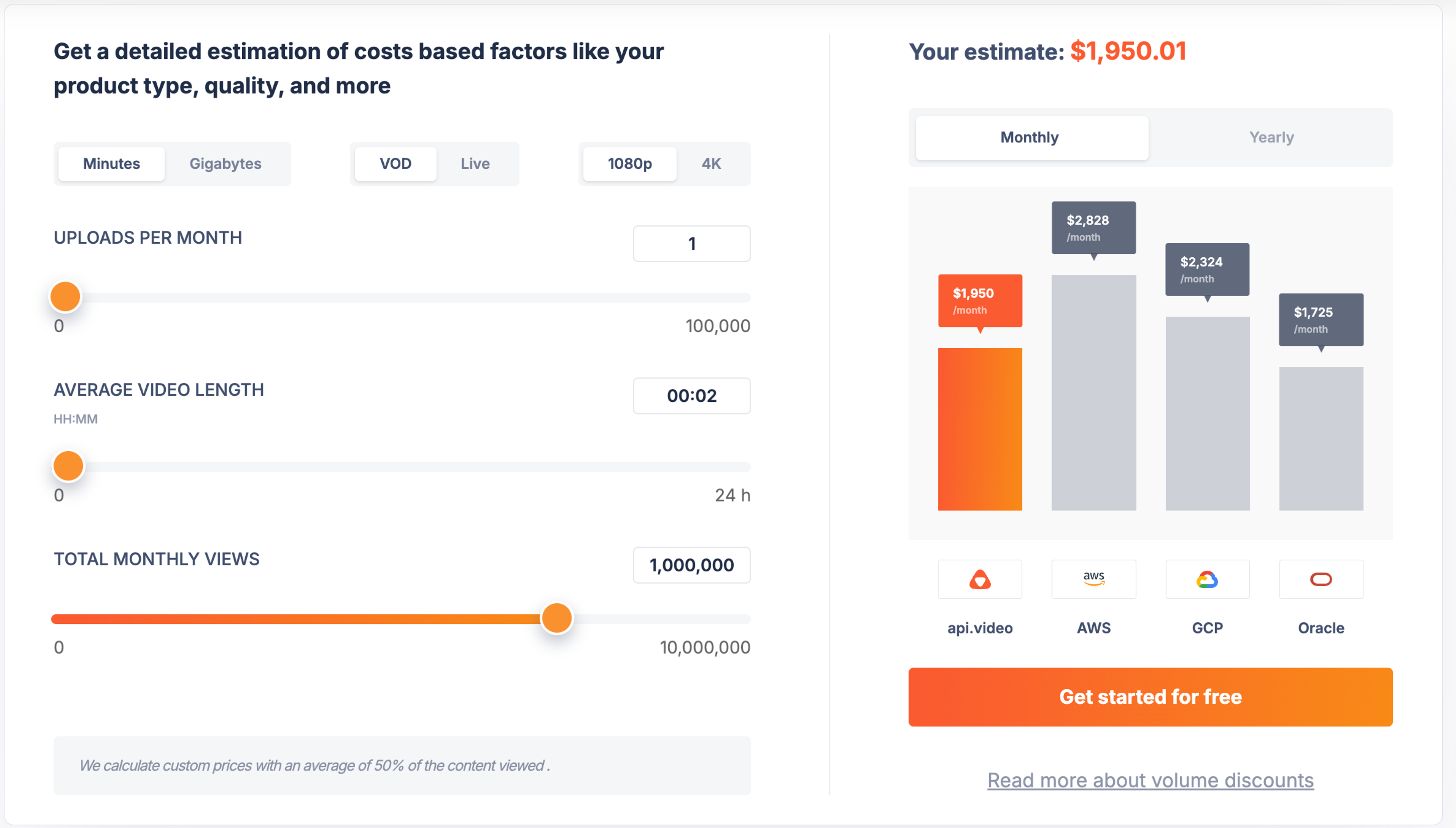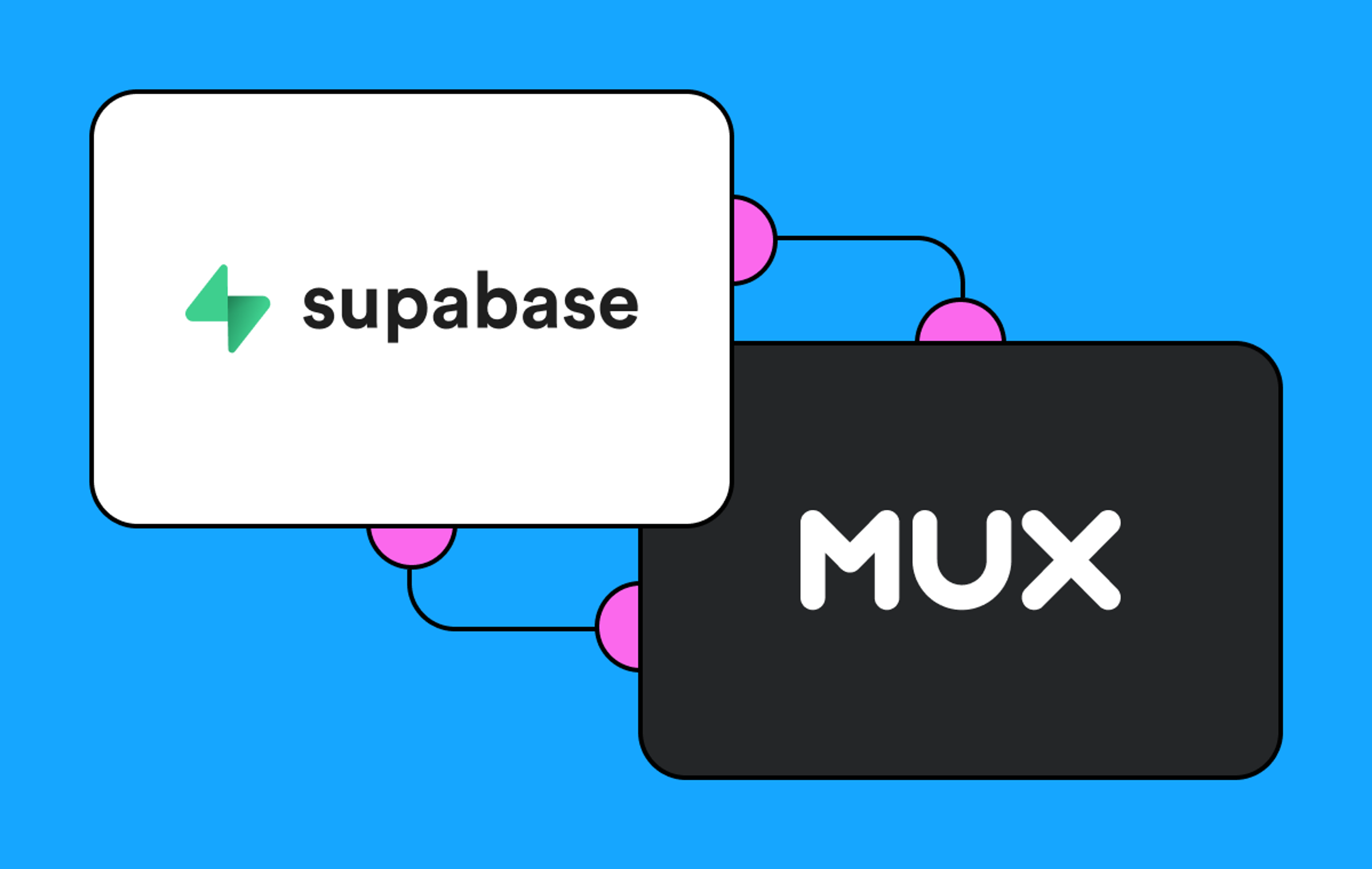One of the misconceptions we see a lot from people with "simple" video use cases is: I can just put my video on S3 and use the <video> tag on my website.
It's true, you can! And if that works great for you, and you're happy, then more power to you. Keep doing what you're doing!
But before everyone assumes it's better, let's do an honest comparison. We'll work through a few examples, starting with the most obvious: price. There are some other factors too, but we've done a LOT of pricing work, so this feels like a good place to start.
Example: a 2 minute video that is being watched by 500k viewers
Let's say you have a 2 minute demo video on your marketing website. This is extremely common and something we're all familiar with. How do the costs compare?
The baseline assumptions we'll make are:
- Video bitrate: 5 Mbps at 1080p. This is a fairly standard bitrate for a 1080p video.
Understanding the video bitrate is a key factor, because S3 charges based on bandwidth and Mux charges based on minutes, so that is going to make a big difference.
Bitrate/resolution | Viewers | S3 | Mux |
|---|---|---|---|
5 Mbps/1080p | 500k | $3,237 | $880 |
Here's the math:
S3
5 Mbps for a 2 minute video is 75 MB file size
5 Mbps / 8 = 0.625 Mbytes / second
(0.625 Mbytes / second) * 120 seconds = 75 MB fileS3 list pricing is 0.09 / GB (first 100GB is free)
- 0.09 / GB for the first 10TB
- 0.085 / GB for the next 40TB
500k viewers * 75 MB = 37,500 GB
37,500 GB - 100 GB = 37,400 GB
10,000 GB * $0.09 = $900
27,400 GB * $0.085 = $2,329- Total: $900 + $2,329 = $3,229
Mux
- 2 minute video for 500,000 viewers = 1,000,000 minutes delivered
- first 100k minutes free = 900,000 minutes
500k minutes @ 1080p @ $0.001 = $500
400k minutes @1080p @ $0.00095 = $380- Total: $500 + $380 = $880.00
That's 73% cheaper than S3.*1
What if you put Cloudfront in there
Let's be honest here, because I want this to be an honest comparison. Most people are putting the Cloudfront CDN in front of S3, so what does that look like:
Cloudfront
- 1 TB free
- 0.085 / GB for the next 9TB
- 0.08 / GB for the next 40TB
- 10,000,000 HTTP requests free per month (after that it's $1 / million HTTP requests)
37,500 GB - 1,000 GB = 36,500 GB
10,000 GB * $0.085 = $850
27,500 GB * $0.080 = $2,200- Total: $850 + $2,200 = $3,050.00
Viewers | S3 | Cloudfront | Mux |
|---|---|---|---|
500k | $3,237 | $3,050 | $880 |
- Slightly cheaper than S3, but Mux is still 71% cheaper.
S3 isn't the only option, let's look at some other comparisons
S3 is the comparison that comes up most frequently, especially for the use case of a static video on a marketing site, but there are certainly other options. The layers of abstraction and dimensions for billing are quite different, which can make 1:1 comparisons difficult, but we'll do our best here to take a look at some more options.
Cloudflare R2
The list pricing for Cloudflare R2 is a little more opaque. The egress is free, but there is a fee for "Class B Operations" — which includes reading a file GetObject . You get 10 GB of storage for free, and you get 1 million Class B Operations for free. When you go over those amounts you can pay for more Class B Operations at $0.90 per million. Beyond that it's unclear and I don't know what the truth is.
Cloudflare Stream
According to Cloudflare's documentation on pricing for Stream: "Delivery is a post-paid, usage-based pricing dimension billed at $1 per 1,000 minutes delivered."
So $1 per 1,000 minutes delivered = $0.001 per minute delivered.
Therefore:
- 1,000,000 mins delivered at 1080p @ $0.001 per minute delivered = $1,000.00.
(Worth noting here that Cloudflare Stream doesn't reduce their pricing to deliver at lower resolutions. If our video was 720p, Cloudflare would still charge you $1,000 to deliver that content. Mux would charge 720p delivery rates – giving you a monthly cost of $590.)
Vimeo
Comparing our cost to Vimeo is tricky. Looking at Vimeo's pricing page, they include 2TB a month of bandwidth in their $125 per month plan. But we need way more than that — over 36TB a month based on our calculations.
If you exceed this volume, Vimeo says:
"Bandwidth is the data used in order to deliver your videos to viewers. We've set the bandwidth limit on our self-serve accounts to 2 TB (2,000 GB) per month. We've set the limit so that 99% of our users will never reach it. You can always track your bandwidth usage within your account. If you do end up reaching that monthly limit, you will receive notifications asking you to lower your bandwidth consumption or discuss a more suitable plan with our sales team."
So you'll need an enterprise contract and it's still unclear how much you'll pay.
From some digging around Google and asking ChatGPT, I found references to several posts from Reddit, HackerNews & other sources discussing the plans Vimeo offered users after they exceed the 2TB monthly limit. The bandwidth rate varies between $0.05-0.09 per GB based on these posts – which for our 36.6TB monthly would land us somewhere in the range of $1,800-$3,925 per month.
api.video
api.video doesn't have their full pricing publicly available, so we'll run our comparison based on the information on their pricing page.
Using their public pricing calculator for the same use case of 1 million minutes delivered, we land on the pricing below. (We doubled the number of views since they assume users will only watch 50% of the video – a fair assumption, but we know our usage will be 1 million minutes of video delivered.)
This gets us to $1,950.01 to deliver this video. If we give them the benefit of the doubt, their calculator quotes that video delivery can be "as low as $0.0017" — so we'll give them a total cost of $1,700 for our use case.

Final breakdown
S3 | Cloudfront | Cloudflare Stream | Cloudflare R2 | api.video | Vimeo | Mux |
|---|---|---|---|---|---|---|
$3,237 | $3,050 | $1,000 | ??? | $1,700 | ??? | $880 |
Run the numbers!
I'm not going to sit here and try to convince you that Mux is cheaper or better for every use case, that's your job! All I'm saying is that you can run the numbers and see for yourself. You might have a super low bitrate video where the bandwidth cost is so low that Mux's per-minute pricing actually starts to hurt you — if you do have this problem, by the way, please reach out — we'll work something out.
Or you might have a ton of AWS credits you're sitting on, so the cost is effectively $0, that's cool too. By the way, we'll give you credits too through the Startup Program, or some other means to help you transition.
If you haven't taken a look at your AWS bill in a while and you have some videos sitting there, maybe crack open that AWS console and see how much that video is costing you. You might be surprised.
Transparency is the Mux way
At Mux, we prefer to be transparent with our pricing every step of the way and we know that might hurt us in some comparisons with other companies but we think that's the right way to go about it.
In fact, you will never be contacted from a Mux account executive to ask you to start paying more. When our account executives reach out, it's to ask you to pay less (only if you want to)!
We have a number of resources to help you figure out and forecast accurate pricing for your usage model:
You can stay on our public pricing tiers for as long as you like. You will see that as you start growing you automatically get cheaper rates. Once you hit a significant level of spend (~$3k / month), then we have the ability to offer you even lower rates if you want to commit to an annual contract (along with a few other benefits like SSO, dedicated support, etc.). But that's ultimately up to you, there's no pressure from our side. You can always stay on our public rates for as long as you like. The video infrastructure you get is the exact same whether you pay us $0 or you're our biggest enterprise customer, everyone gets best-in-class, reliable, cost-effective and high performance video infrastructure.
How is Mux able to sustainably provide this level of pricing?
It certainly wasn't like this 2 short years ago, but a LOT of work has gone into this, we'll re-purpose a graphic that we shared in Jon's blog post.

We've had a whole series of releases and improvements that can be split out into 3 buckets:
- Pricing levers — like resolution-based pricing across encoding, storage and delivery, de-coupling static renditions, cold storage and basic encoding.
- Infrastructure changes — we're running some of our own infrastructure, instead of relying on public clouds for everything.
- Good old optimization — a ton of work has gone into every step of our pipeline, squeezing every bit of CPU efficiency we can out of our systems (we're not done yet).
Read more about these pricing drops in Phil's blog post.
If you are going to use another vendor for your video infrastructure, we have an answer for your video player
If you are going to use a static file hosting service or another vendor, you still probably want a nice video player. Media Chrome (the framework behind Mux Player) is open source, so check that out:
- Media Chrome - the framework for building media players
- player.style - a collection of themes for Media Chrome
Not to mention everything else you get from Mux
It also should be noted that Mux is not static file storage for your video. It gives you a lot more functionality out of the box, I'm talking about
- Auto-generated captions & transcripts
- Ability to create clips from videos
- Extract images & GIFs on the fly
- A very good video player with timeline hover previews, a rendition selector, chromecast, airplay, Mux Data built in (free)
- DRM, if you need studio-level protection for your content




